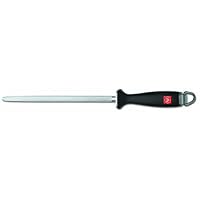 This steel is just the right thing for honing blades right before using them (for more intensive sharpening use a stone). I only have a few objections:
This steel is just the right thing for honing blades right before using them (for more intensive sharpening use a stone). I only have a few objections:I own two steels, one obtained two years ago that doesn't have the washer-shaped metal guard between the handle and the shaft, and one obtained four years ago that does. The one that does has collected a lot of scratches on the guard. I can't help but wonder if hitting that metal has also hurt my blades.
The wusthof logo is stamped onto the shaft, into the metal grooves, right where the tip of a blade passes. When honing a long blade I wind up holding the steel so that the blade doesn't hit the logo. (Those raised ridges can't possibly be good for the edge). But this means I only get to use half of the steel.There are really two main competitors in the high-end mainstream kitchen knife market: Henckels and Wusthof. Those who have used both usually have a preference. My preference (and therefore bias you should know about) is for the Wusthofs.
The Wusthof Classic line is the more conservative counterpart to the Grand Prix line. The only difference, however, is the handle style. I personally prefer the Grand Prix, but this is an issue of personal preference.
However, when it comes to sharpening steels, I have found very little difference. As long as you buy a high end steel, you really won't go wrong. Therefore, I shop for this item on price, and Henckels has a price advantage. Unless you want a matching set, shop on price, and look to Henckels.
Buy Wusthof 10-Inch Sharpening Steel Now
It took 22 years to wear out my original Wusthof Sharpening Steel. Their products are premium, world class and worth every penny. I value my knives highly and wouldn't consider any any knife manufacturer.While there is no substitute for a knife sharpener, steeling your knives after every use (I do it when drying and putting away my knives), keeps the blades true and does allow you to go a little longer between sharpenings. If you're serious about cooking, you need a steel.
0 comments:
Post a Comment